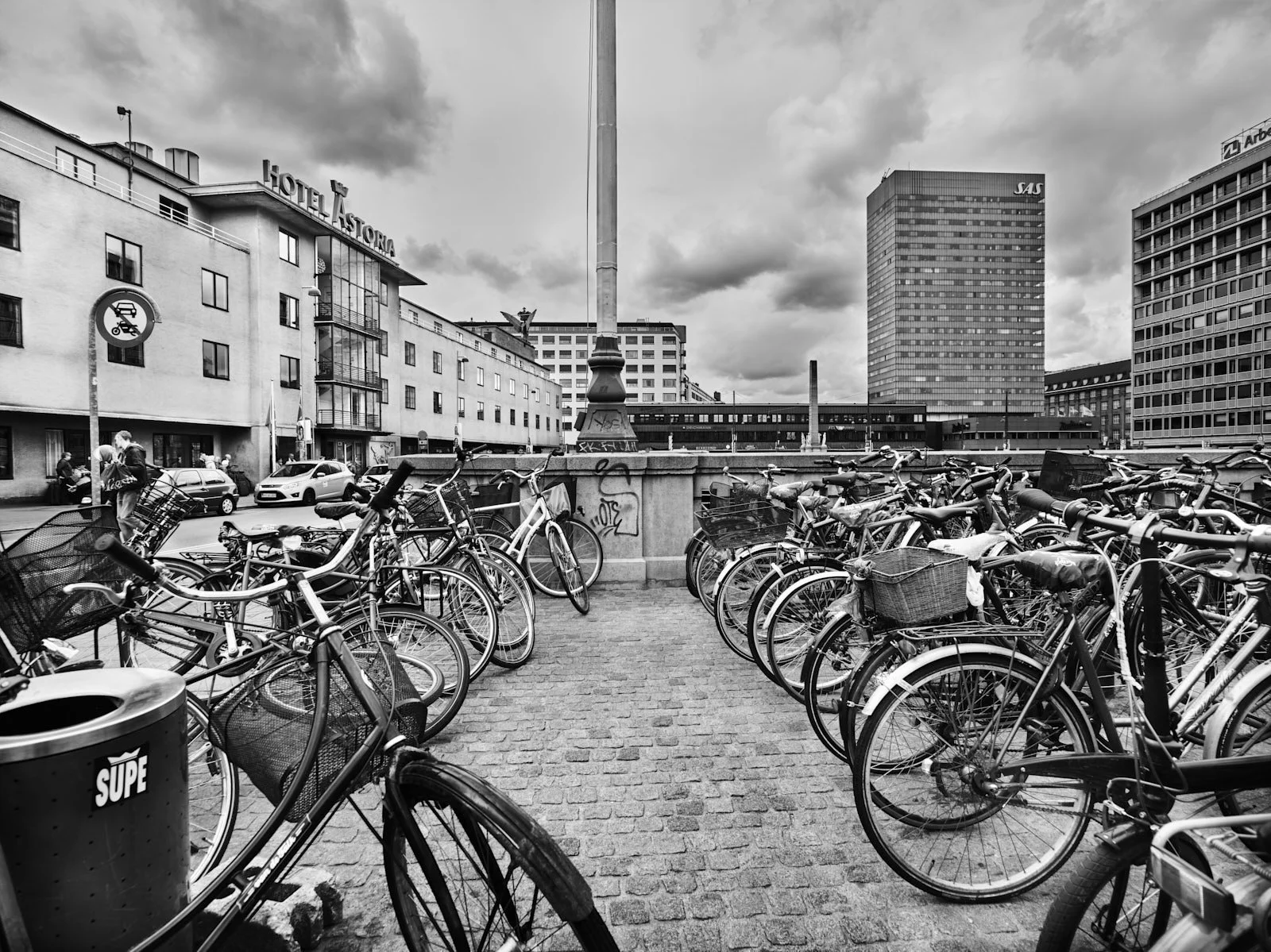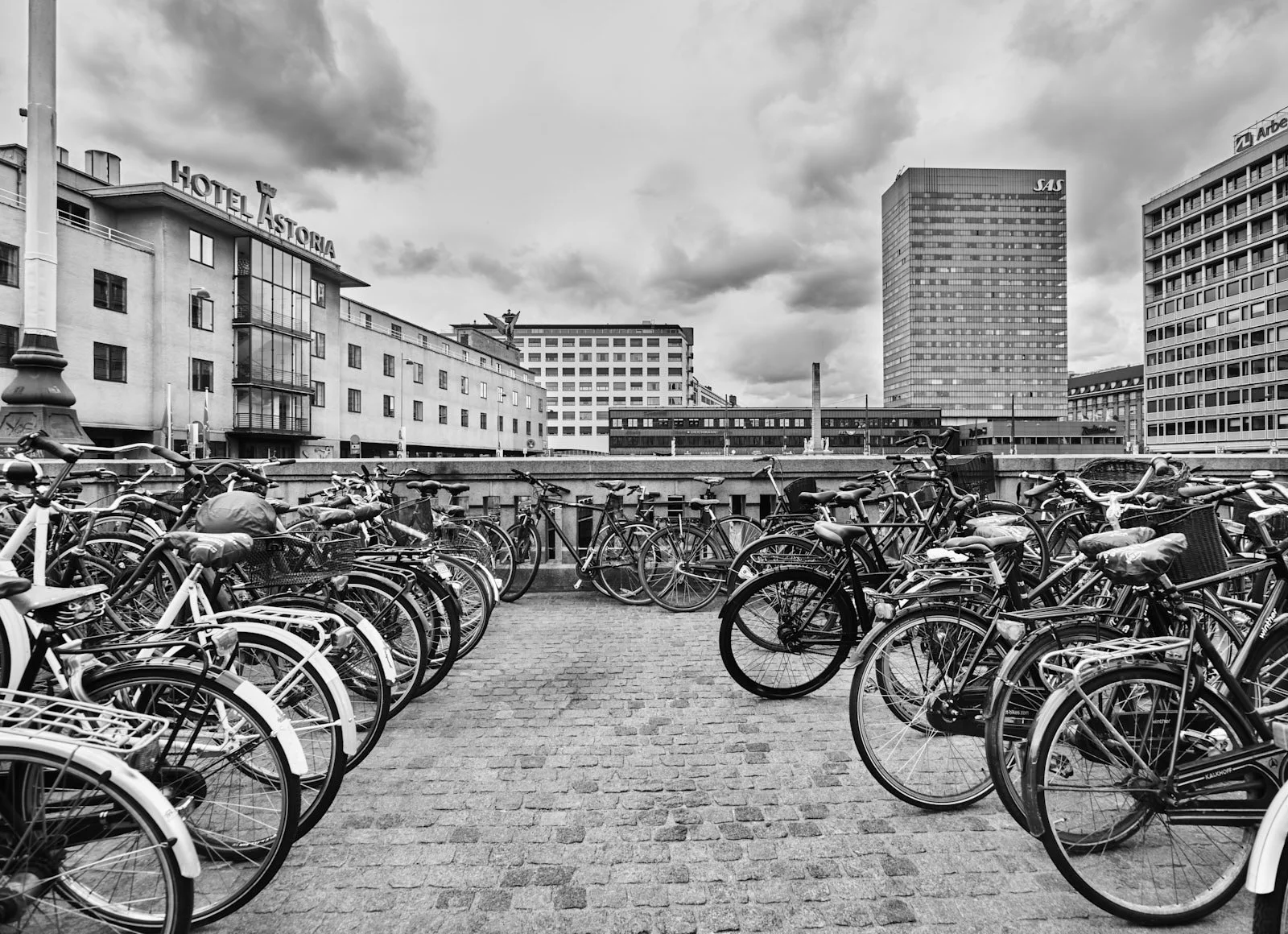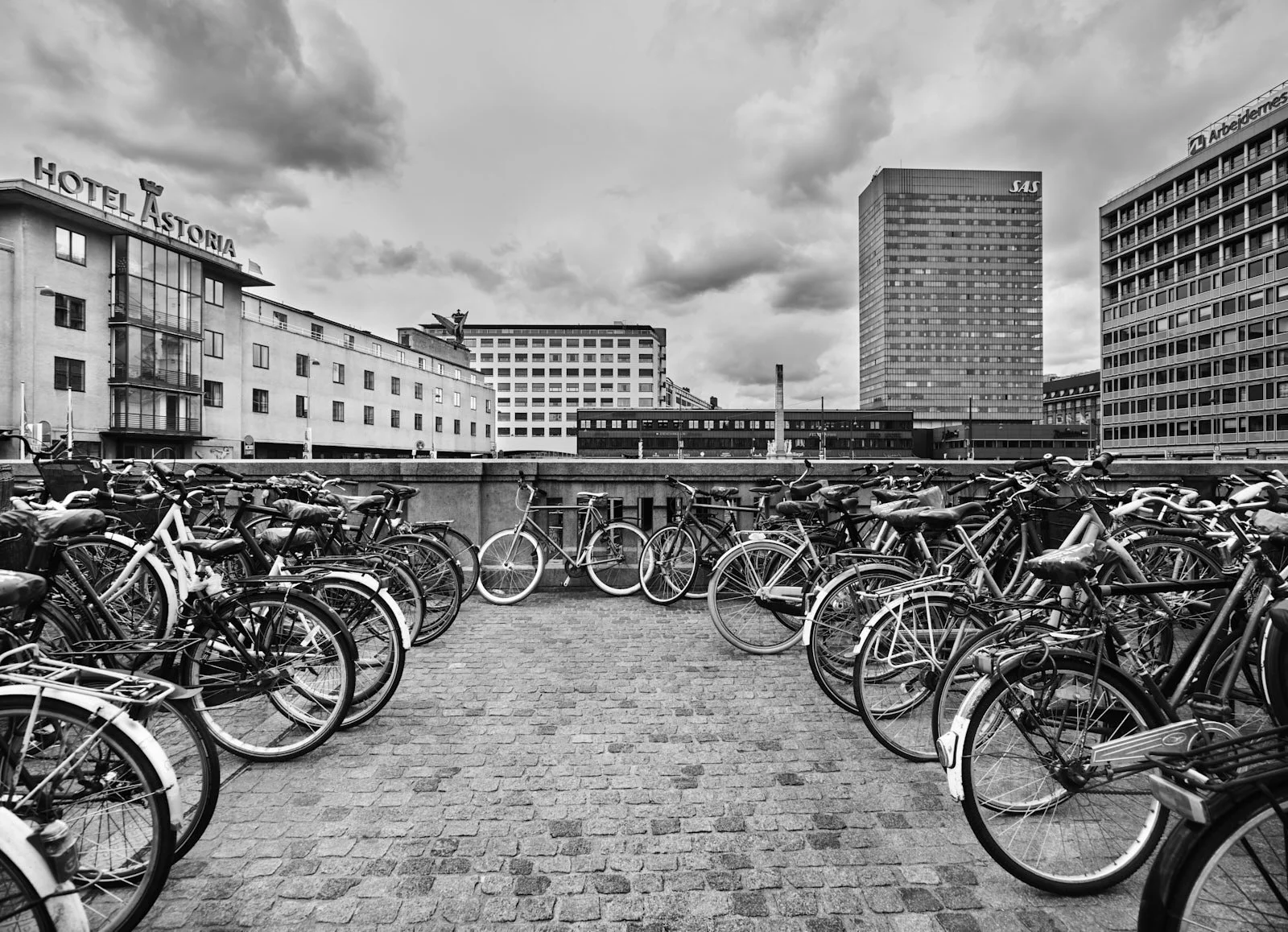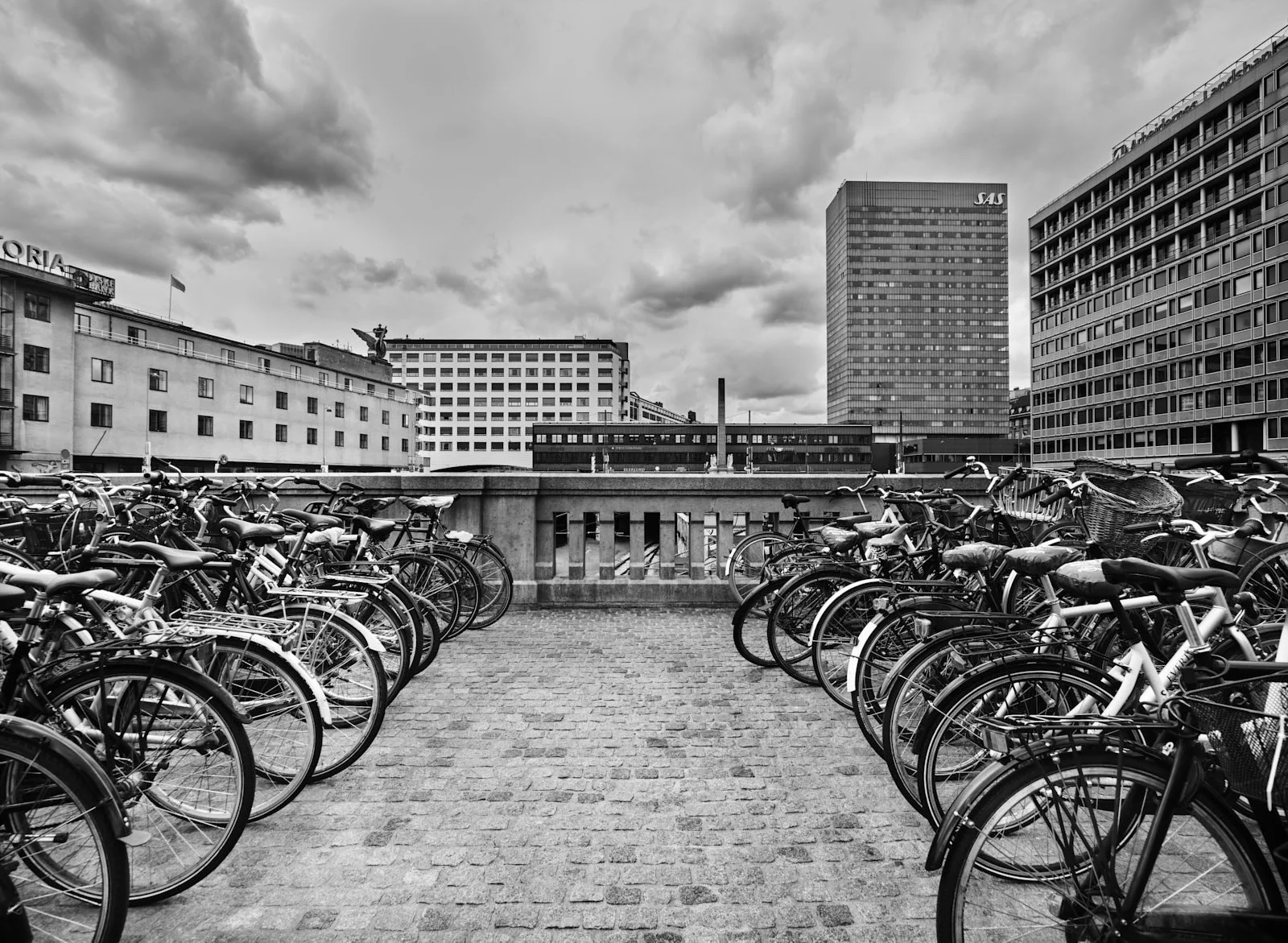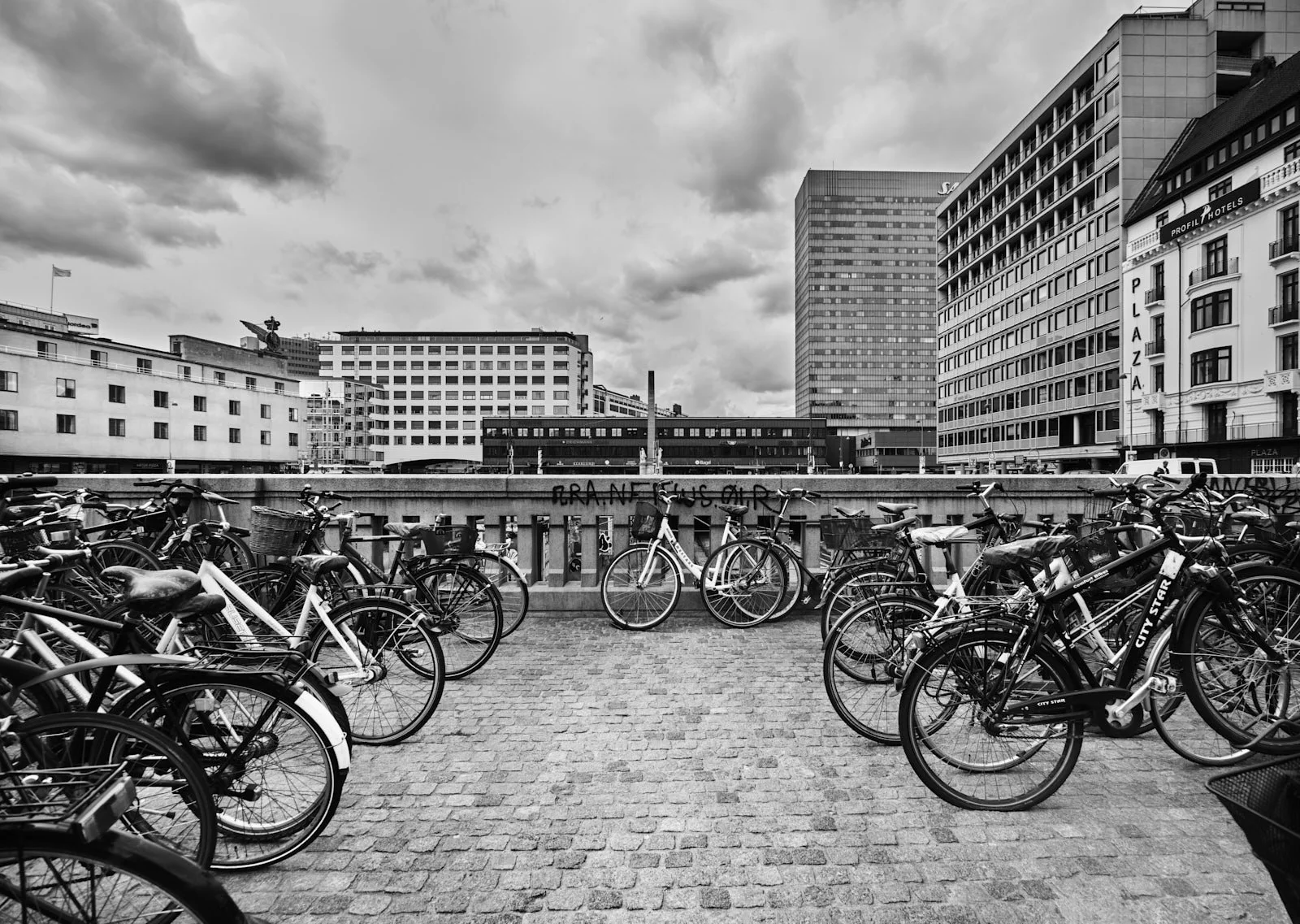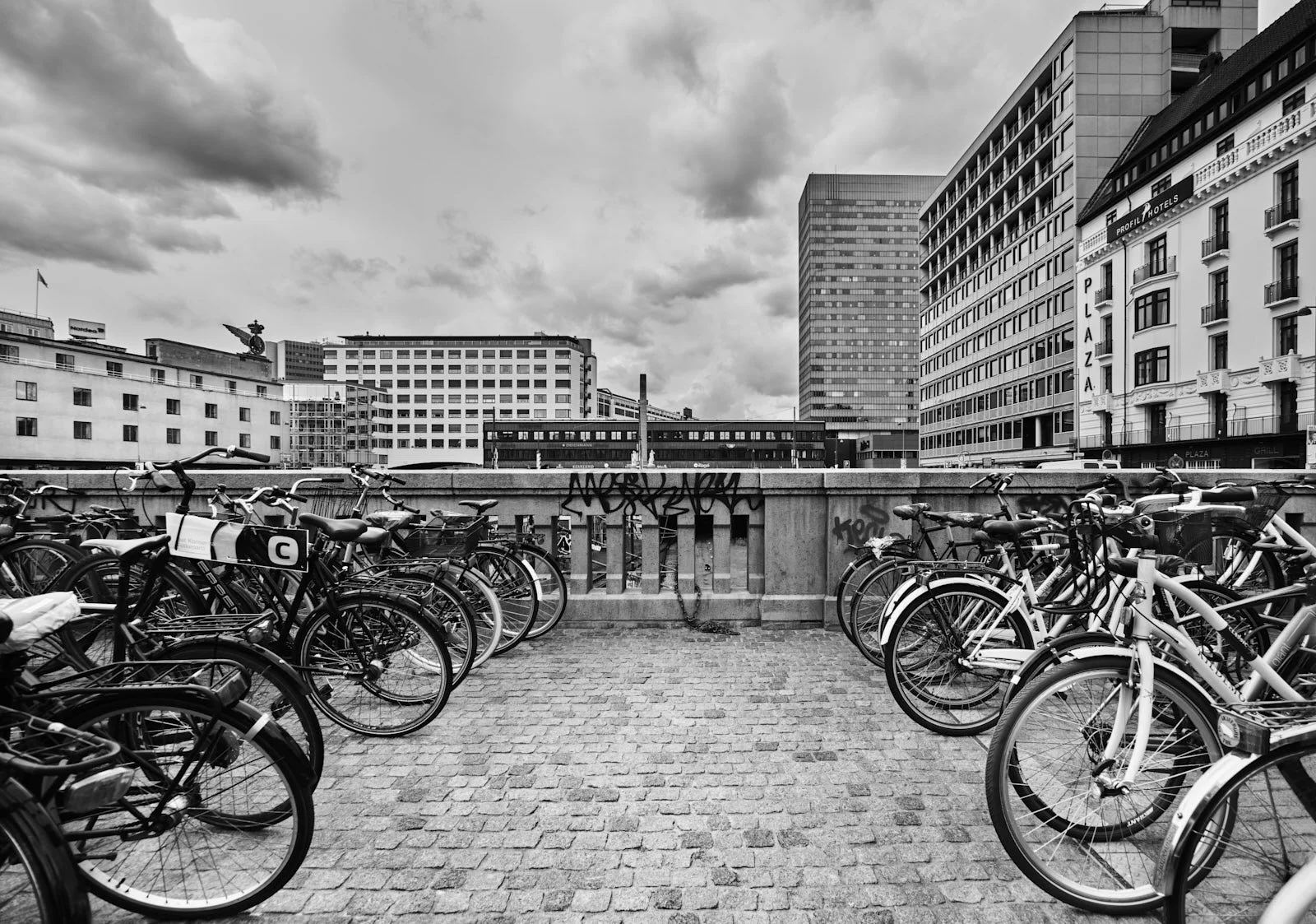Musings: Copenhagen Bikes
My favourite way to exit the Copenhagen main train station is through the north exit which opens onto Banegårdspladsen, a plaza with a street for cars, a 2nd lane for car parking and a thrid area for bike parking. What’s noticeable first is bicycles; possibly thousands of them. This is so visually foreign that a study had to be made. It took 8 years for that to happen. Lining up weather, gear and the best time of day is like herding cats.
Everything lined up on a 2015 visit. The moody dark clouds were ideal for highlighting the patina in the buildings and the cloud cover was the perfect shadowless light for the chaos of bikes. The Copenhagen train station north exit plaza is a block wide deck that sits above the main railway tracks. Bike racks create bike parking aisles, 9 of which are the images in this study. Sometimes, a study resonates on so many levels that it takes on a new meaning once it’s completed. This is one of those studies.
Bikes, hotels and history
It made sense to just break all the rules and split the image horizontally with the cement railing right across the middle. This is two images clashing; the chaos of bikes and the symmetry of the buildings and yet balancing each other.
With this studies compositional focus on the bike aisles, elements fall where they may. The flag pole seems out of place yet that is where it exists. It’s a huge affair with a massive Danish flag at the top. When standing in this spot, the flag pole visually takes over and it’s no different in the study.
The bikes on the left are lined perfectly. The bikes on the right follow a pattern of their own.
Why are the bikes on the left perfect and the ones on the right not perfect? The bikes on the right are actually double and triple parked. Maybe this is a physical manifestation of convenience. If running late and the bike lanes are full, it makes sense that a bike just gets stuffed anywhere. So why did so many pick the right? This is order and chaos, both being respected and accepted following unspoken rules. It’s almost like digital on the left and analog on the right. Maybe this is a left brain right brain thing or maybe this is just coincidence. Somewhere I read that coincidence is just the truth trying to get out.
Copenhagen Bikes Aisle 1
Copenhagen Bikes Aisle 2
Aisle 9 is the last full bike aisle. A few bikes where parked on the other side of this aisle but with limited space and a street, the risk of damage to a bike is probably too high for most.
he solid strip on the right shows where the wall going down to the tracks below is positioned. The bikes to the right of that line are not on a plaza but on terra firma.
This is a simple study yet oddly complicated. Maybe it’s best described as a reflection of what’s there. Copenhagen is wildly complex and simple at the same time. It’s a bit like an onion that seems to have layer after layer as you go deeper, except the layers never seem to end and they interact. It’s a remarkably wonderful thing to experience. IF you happen to be a cyclist, without question, Copenhagen is paradise.
Copenhagen Bikes Aisle 3
These Bikes are not as packed. It’s late afternoon. Maybe parked bikes here are the early ones who have already gone home.
The Hotel Astoria on the left really stands out. The Hotel was commissioned by the Danish State Railway as a station hotel and was completed in 1935. The building was designed by Danish Architect, Ole Falkentorp who was part of the Functionalist Architectural movement. Ole’s cubist design is also an excellent example of Architecture Parlante, where the building expresses its purpose. by how it looks.
Aesthetically, the building was designed to look like a steam locomotive which in 1935 was a symbol of modernization. It was the first Modern luxury hotel in Copenhagen and had one of the first rotating doors installed in Denmark.
The Hotel Astoria has a certain tension that might well be a reflection of the state of Europe in 1935. Oddly enough, I have never stayed in this hotel.
Copenhagen Bikes Aisle 4
The order of the bikes gets better and better. Even the bikes at the cement railing are lined up. The one exception is the bike on the right side with the black fender. This odd bike really stands out.
After capturing this image, my curiosity got the better of me and I took a close look at the bike. The bike chain was pretty rusty. It had not moved in a very long time.
Do abandoned bikes get removed? After all, these rows and rows of bikes are everywhere in Copenhagen and the rest of the country. Lost and forgotten bikes must start to pile up.
Copenhagen Bikes Aisle 8
Copenhagen Bikes Aisle 5
Aisle 5 sits in the centre of the study clearly allowing for some details of the tracks below to show through. The plaza is so large that at first it seems like solid ground until this point.
For cyclists, Copenhagen is a paradise but there are a lot of bikes. At the time of this study, the population of Copenhagen was about 600,000. A the time, it was estimated there were more than 700,000 bikes. Bike parking is sometimes a serious problem. In some areas bikes get parked all over the place making it hard to walk on the sidewalk. In places, the bikes are parked so deep there is no clear way to get a bike unlocked and out.
Copenhagen Bikes Aisle 6
This is the 2nd to last aisle. So much open parking space. Early to work might mean early to home. This is closer to the large street Bernstorffsgade which is made to handle bike and car traffic in volume.
The focus with the buildings is now on the Plaza Hotel, the third and last hotel in this study. King Frederik VIII commissioned the Plaza hotel in 1913 and it opened in 1914. Up until World War II, the Plaza Hotel (then called the Terminus Hotel) was used by royalty and dignitaries waiting to see the King. The original hotel had 56 rooms that included a telephone and a bathroom. with 46 of the bathrooms including bathtubs. The remaining 8 rooms had showers. In the era, this was seriously modern.
In the early 70’s the Gobelinsalen (Tapestry Hall) which was a lounge and library designed as a sitting room for royalty and dignitaries was converted into the Library bar. Forbes magazine rated the Library bar as one of the top 5 bars in the world. It is definitely worth the visit and if you love classic European Hotels marking the era of Royalty, it’s well worth staying in.
Graffiti and stains try to balance the tiny strip of sky between the SAS Royal Hotel and the Arbejdernes Landsbank building. Another serious broken rule of composition. A vertical white lighting rod.
The SAS Royal hotel was designed by the legendary Danish architect Arne Jacobsen and is the only hotel he designed. The iconic Tulip Chair was originally designed for the hotel as part of a complete furniture package. The architectural design was completed in 1958 and the building was completed in 1960.
The SAS Royal Hotel was the first skyscraper in Denmark and has become an international landmark of mid-century modern Danish design.
Each room is like an Arne Jacobsen museum, except you get to stay and use the room. If you like mid-century modern furniture and architecture, the SAS Royal Hotel should be at the top of your list. Radisson Hotels are the current owners and have completed a significant restoration of the original furniture and the hotel itself.
The theory that most cyclists tend towards order when parking bikes in Copenhagen gets more likely as each aisle is studied. Aisle 7 has the most perfect.ly lined up bikes. The only exception is the bike parked against the cement railing which looks posed since in my mind, it sets the perfect visual balance. The cement railing shows little of the tracks below.
The buildings on the right dominate but somehow there is a little more balance as the white Plaza Hotel grows larger with the single bike at the back of the aisle setting a direction. The clouds are getting darker and a light drizzle is starting. Time to finish the study.
Copenhagen Bikes Aisle 7
Copenhagen Bikes Aisle 9
Galleries

